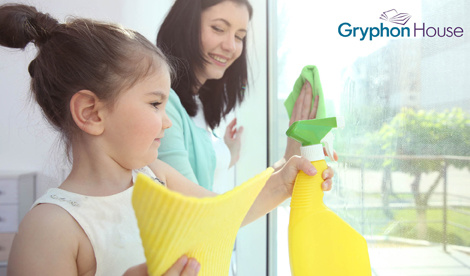Cleaning your classroom doesn’t have to be just another chore! Introducing clean up songs for the classroom to your students is a wonderful way to get students involved in keeping the classroom tidy. It’s also a great way to transition from one activity to another, saving you a classroom clean up later on. Sharing a clean-up song with your little learners is a fun and simple way to encourage their participation in making the classroom a clean and comfortable environment for everyone. Songs and classroom clean up games also allow students to take pride in their classroom while building their self-confidence when they learn about responsibility first hand.
Transition Time is a great teacher resource full of transition activities for preschoolers. Here are a few clean-up songs and games you can use the next time you have a messy classroom!
Tidy-Up
When?
Sing this tune to the children when it’s time to clean up.
Why?
Children respond more readily to a pleasant song than to demanding statements.
What?
No materials are needed.
How?
While putting away toys, begin singing this song to the tune of “Jingle Bells.”
Tidy-up, tidy-up, put the toys away.
Tidy-up, tidy-up, we’re finished for today.
Oh, tidy-up, tidy-up, put the toys away.
For we’ll get them out again
The next time that we play.
Timer
When?
A timer helps children bring closure to their activities and encourages them to participate in clean-up time.
Why?
Time has little meaning for children, but a five minute warning helps them feel more prepared and responsible.
What?
Timer
How?
- Set the timer for five minutes.
- Remind children that when the timer goes off it will be time to finish playing and clean up.
- When the timer goes off, sing one of the clean-up songs.
- Start cleaning up, and the children will, too.
Puppet Pals and Inspectors
When?
Check to see if everything is in its place with a puppet pal or inspector.
Why?
Children enjoy taking responsibility for making sure the room is cleaned properly. In addition, giving children responsibility empowers them and makes the classroom less authoritarian.
What?
Hand puppets or stuffed animal
How?
- When children are just about through cleaning up, put the puppet on your hand and let the puppet go around the room and inspect various centers.
- Talk in the voice of the puppet, or let the puppet pretend to whisper in your ear and repeat what it says to the class.
- Give positive comments such as “Puppet pal likes the way all the puzzles have been put together,” or a reminder like “Puppet pal sees some blocks we need to put on the shelf.”
- After modeling what to do with the puppet, let the children take turns using it to inspect the room and give feedback to other children.
Author(s)Jean Feldman
Jenna Roby
A graduate of High Point University, Jenna Roby served as marketing specialist for Gryphon House from 2013-2015.

